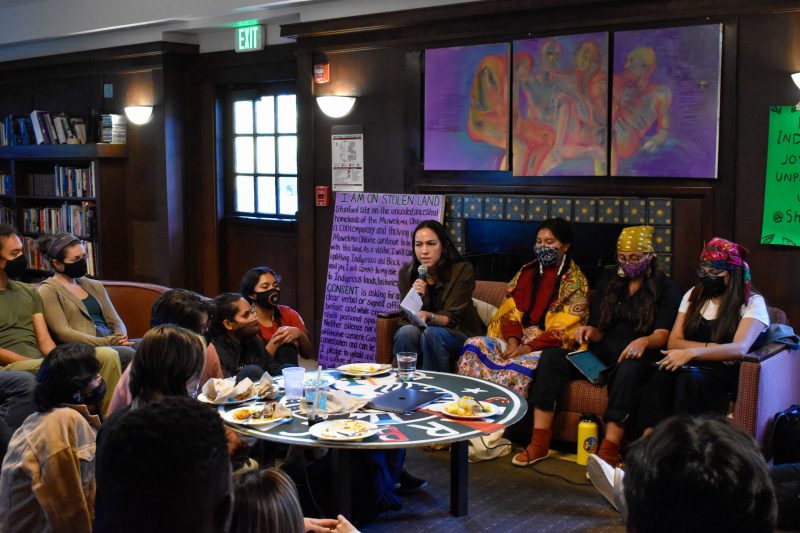Indigenous students led a teach-in on Monday in honor of Indigenous People’s Day, where they shared personal stories of being Indigenous at Stanford. Students also shared how they are navigating what they described as the University’s minimal support for the Indigenous community.
The event began The event began with a prayer and an in-depth land acknowledgement, read by Shayna Naranjo ’21 of the Santa Clara Pueblo. The land acknowledgment was written by Rachel Lam ’21 of Anigiduwagi enrolled Cherokee Nation and Hope Harrington ’19 of the Northern Chumash.
“Stanford and Stanford affiliates are administratively intertwined and complicit in the settler-colonial reality of the Bay Area,” Naranjo read, referring to Stanford’s location on the unceded land of the Muwekma Ohlone Tribe. “This means that Stanford and Stanford affiliates have a responsibility in assisting the Ohlone to reestablish their environmental stewardship through advocacy, institutional programming and monetary support. All people interacting on Ohlone homeland have this responsibility.”
Despite President Biden designating Indigenous People’s Day a federal holiday, Stanford did not cancel classes in observance of the day — a move that some Indigenous students criticized as insufficient.
When The Daily asked University spokesperson E.J. Miranda about the lack of a University statement to honor the holiday, he provided information on the launching of a new land acknowledgement website. Miranda did not comment on whether the University considered either closure or other actions to amplify Indigenous voices on Indigenous People’s Day.
Alyssa LaTray ’23, of the Little Shell and Blackfeet Tribes, acknowledged Stanford’s recent rollout of its land acknowledgement website, but said that she feels it’s just a starting point. “To not have tangible change after that is really disappointing,” LaTray said.
Both LaTray and Tim Rosenberg Jr. ’23 of the Seneca Tribe said that while they had no expectations for the administration on Indigenous People’s Day, they believed that the University should have cancelled classes in observance of the holiday.
Another Indigenous student in the Class of 2025, who requested anonymity for fear of retribution, highlighted the context of Stanford’s fraught history with the Indigenous community. Stanford’s “mascot was a Native American, a caricature of a Native American person, and they had celebrated Columbus Day before with the day off,” the source said. “But now [they] just won’t uphold that same energy.”
Indigenous students who spoke at the teach-in also brought attention to the fact that it was Indigenous students — specifically Indigenous women — who organized and led the teach-in. Kendra Becenti ’21 of the Diné Tribe and an organizer of the teach-in, said that Indigenous People’s Day is supposed to be a celebration of communities, cultures and histories.
“What I feel like Stanford wants me to do, and what the settler colonial nation wants me to do, is to put my labor, my energy, as an Indigenous woman, into not myself — not caring for me, not my work as a student here — but educating, ” she said.
Several other student speakers expressed a similar sentiment, sharing that they often feel the responsibility falls on them to continually explain Indigenous histories to people with little knowledge and that they are expected to represent a community that is not monolithic, but expansive, diverse and international.
Teach-in speakers said that one avenue non-Native community members could take in supporting Indigenous issues is through engagement with the Land Back movement. While Land Back has many meanings for different people, it is centered around the idea of indigenous sovereignty and reclamation of what has been lost.
On a national level, Land Back is affiliated with movements like the effort to close Mt. Rushmore and return the land to the Lakota people, but students at the teach-in also shared its relevance at Stanford — whether it be through paying a Shuumi land tax or considering the implications of travel on Indigenous communities.
On Friday morning, a Land Back flag will be erected at Kairos, a co-op on campus where the teach-in was held.
“It’s important to show how the labor of Indigenous women students is creating spaces for us and greater visibility for things important to us because Stanford is failing to do so,” Becenti said.
This article has been corrected to more accurately reflect Lam’s personal information, including her name, year of graduation, and tribal affiliation. The Daily regrets this error.
